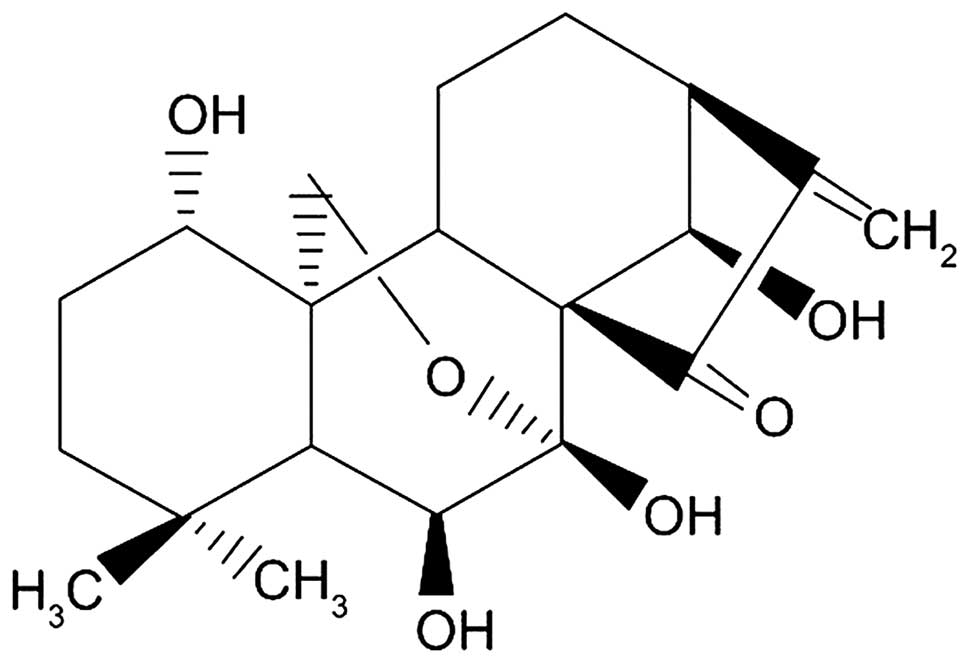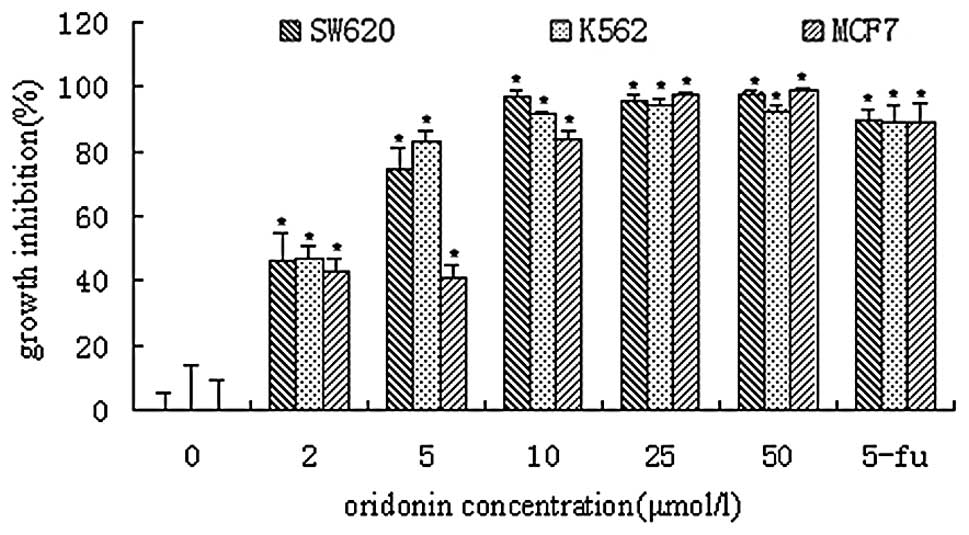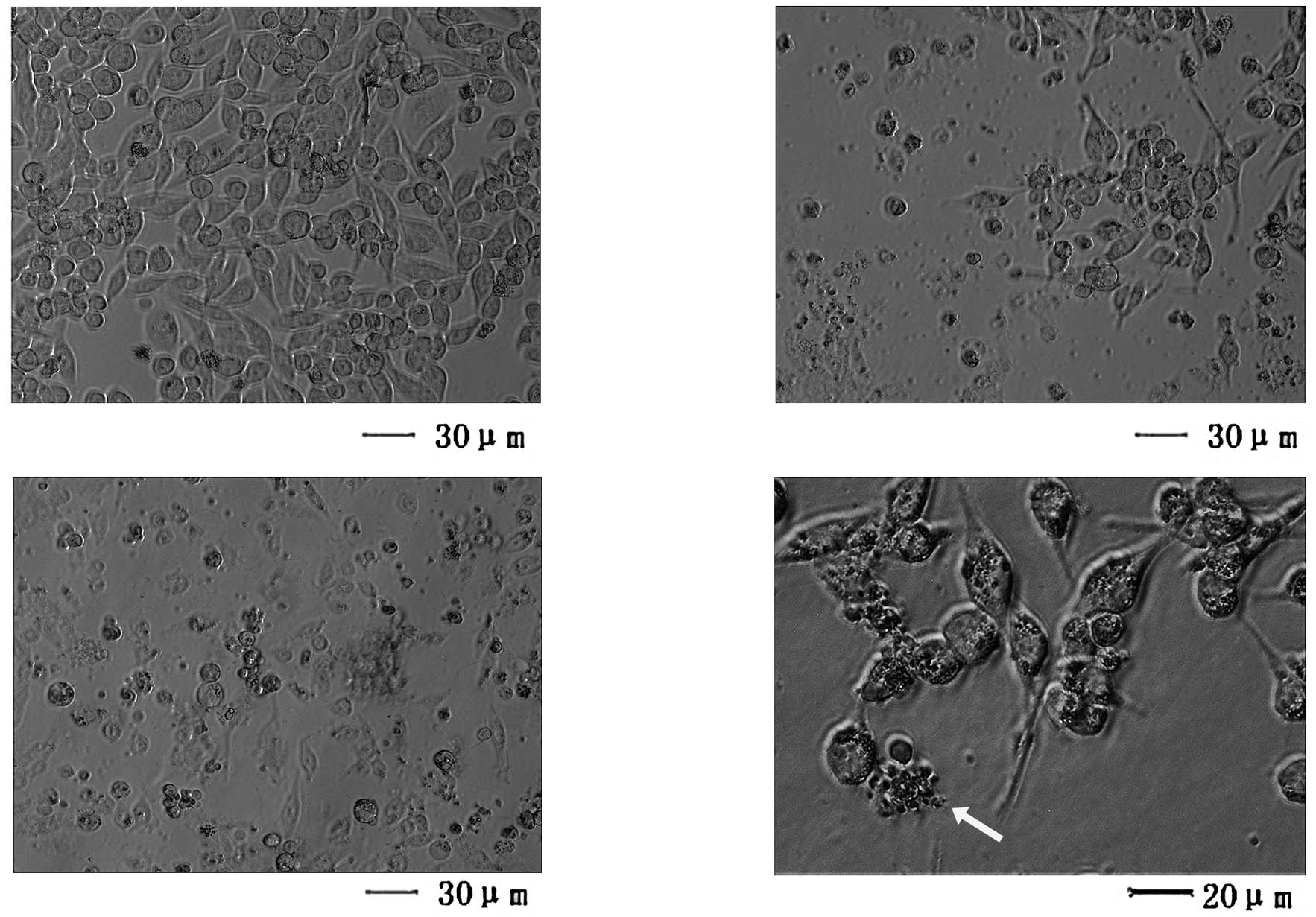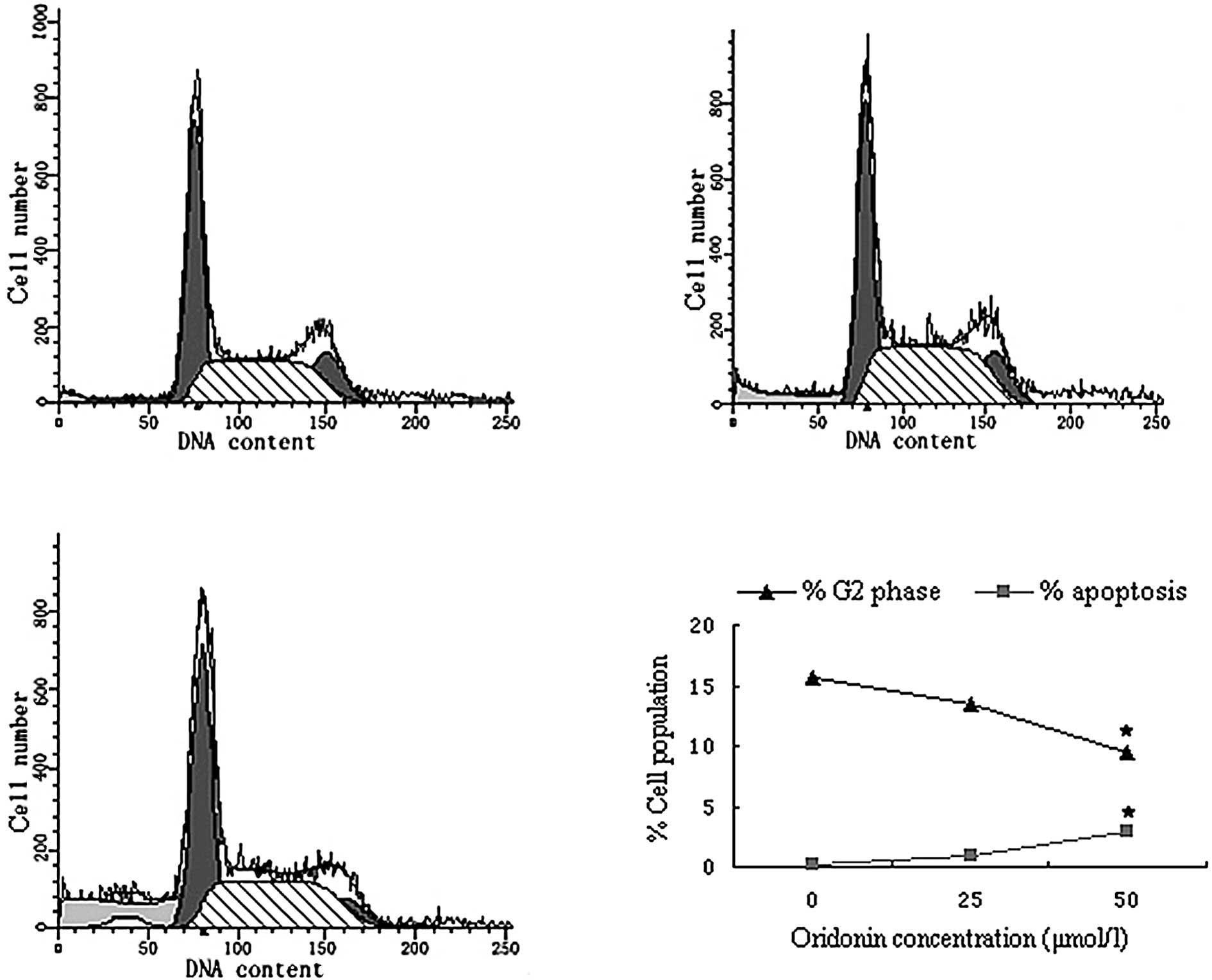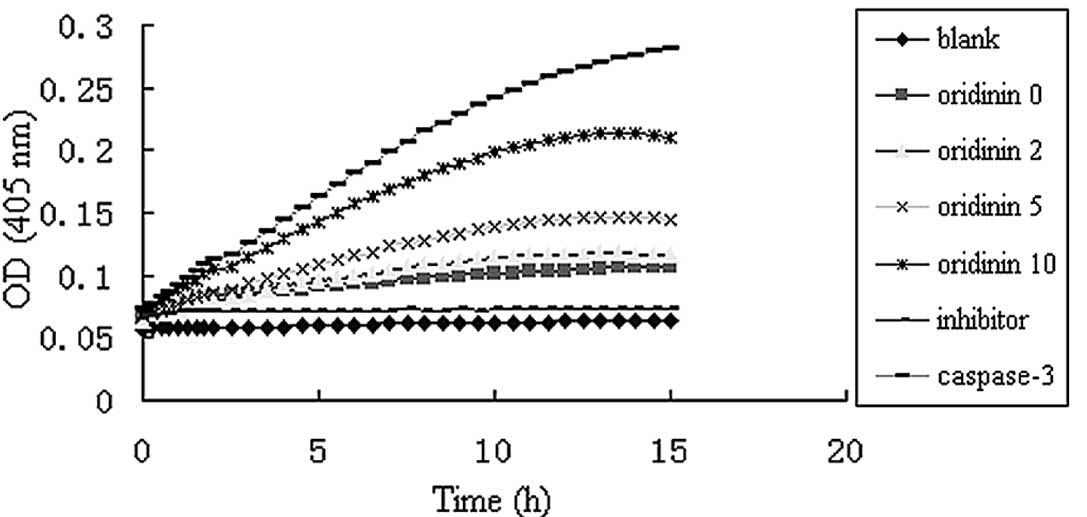Oridonin-induced apoptosis in SW620 human colorectal adenocarcinoma cells
- Authors:
- Published online on: September 2, 2011 https://doi.org/10.3892/ol.2011.408
- Pages: 1303-1307
Abstract
Introduction
Colorectal cancer is a common cause of mortality among cancer patients worldwide. Over 9% of all cancers in males and approximately 10% of all cancers in females worldwide are colorectal cancers. In developed countries the incidence may be as high as 12–14% of all cancers, and in non-developed countries much lower rates of 7–8% of all cancers are diagnosed. Colorectal cancer is the third most common type of cancer diagnosed in the USA. Over 100,000 Americans are diagnosed with colon cancer annually and over 50% of these patients are likely to succumb to the disease.
Oridonin (C20H28O6), an ent-kaurane diterpenoid (Fig. 1) isolated from the plant Rabdosia rubescens (R. rubescens), exhibits a variety of biological properties including anti-tumor, anti-bacterial, oxygen free-radical scavenging and anti-mutagenic activities, and has been used for the treatment of human cancers (1–5). The compound is a chemical component of PC-SPES, a traditional Chinese medicinal preparation consisting of a combination of extracts from eight herbs, used with increasing frequency by prostate cancer patients worldwide (6). The effectiveness of PC-SPES in the treatment of prostate cancer has been explained in part by its complex composition, which is thought to target a number of signal transduction and metabolic pathways simultaneously, thereby eliminating the back-up or redundant mechanisms that otherwise promote cell survival when single-target agents are used (7). Among the individual herbal components of PC-SPES, R. rubescens has recently received much attention (8), and new studies have shown this herb to be the most potent of all PC-SPES agents in terms of inhibiting cancer growth and angiogenesis (9). A major constituent, oridonin, has been extracted and purified from R. rubescens, and shown to exhibit significant anti-proliferation effects on cancer cells (10).
Apoptosis is a form of cell death defined by a characteristic set of morphological and biochemical changes. Previous studies identified a role for caspases, a family of cysteine-dependent aspartate-directed proteases, in apoptotic death, particularly in the context of cancer cells (11). Individual members of the caspase family mediate apoptosis in various cell types, and various caspases have been found to mediate apoptosis even within a given cell type, depending on the apoptotic stimulus received by the cells (12). Caspase-3 and caspase-9 are reported to play key roles in caspase-mediated apoptosis, and variations in their activity have been correlated to apoptosis in a wide range of cancer cells (13–14).
Oridonin has been shown to induce apoptosis of human hepatocelluar carcinoma cells (14). In the present study, the effects of oridonin on cell proliferation, cell cycle distribution and apoptosis of the colorectal adenocarcinoma cell line SW620 were assessed.
Materials and methods
Oridonin reagent
Oridonin was obtained from Shanxi Huike Botanical Development Co., Ltd., China, and shown by HPLC to be 99% pure. Stock solutions were prepared in dimethyl sulfoxide (DMSO).
Cell cultures
Human tumor cell lines SW620 cells (colon), MCF-7 (breast) and K562 (bone marrow) were obtained from the American Type Culture Collection (ATCC) and maintained at 37°C in RPMI-1640 containing 10% fetal calf serum (FCS) (Kraeber, Wedel, Germany), 100 U/ml penicillin and 100 μg/ml streptomycin.
Cell proliferation assay
Aliquots (180 μl) of a cell suspension (1×104 cells/ml) were dispensed into each well of a 96-well microplate, and 20 μl of one of the different test agents (as indicated) was added. Following incubation at 37°C in a 5% CO2 atmosphere for a specified time, 20 μl Alamar Blue reagent (Biosource, Nivelles, Belgium) was added to each well and the incubation continued for a further 6 h. Absorbance values at 570 and 600 nm were determined using a micro ELISA autoreader (Bio-Tek, Winooski, VT, USA) and cell proliferation rates were calculated according to the Biosource protocol.
Microscopic observation
Using SW620 cells cultured as described above, 1×106 cells were treated for 24 h with 10, 25 and 50 μmol/l oridonin, and examined using inverted phase-contrast microscopy. Samples treated with DMSO served as controls.
Flow cytometry
To confirm the nature of the effects of oridonin on SW620 cells, dual-staining [propidium iodide (PI) and annexin V (AV)] flow cytometry was used to measure the externalization of phosphatidylserine (PS). Aliquots (5×106) of SW620 cells cultured as described above were treated with 10, 25 or 50 μmol/l oridonin for 24 h. Controls were treated with DMSO only. Following washing and trypsinization, cell samples were collected by centrifugation (400 × g, 3 min, 4°C) and double-stained using the apoptosis detection kit (BD Biosciences, San Jose, CA, USA) according to the manufacturer’s instructions. Cells were incubated for 30 min at 25°C in 100 μl 1X buffer solution, 5 μl FITC-annexin V and 5 μl PI, and a further 400 μl of 1X solution buffer was added. The green fluorescence of annexin V-FITC-bound PS and the red fluorescence of DNA-bound PI in individual cells were measured using a BD FACSCalibur. Cell populations were classified as: AV−/PI−, viable cells; AV+/PI−, early apoptotic cells; AV+/PI+, apoptotic cells; and AV−/PI+, residual damaged cells.
Cell cycle analysis
Aliquots (5×106) of SW620 cells cultured as described above were treated with 25 or 50 μmol/l oridonin for 24 h. Controls were treated with DMSO only. Following washing and trypsinization, cells were collected by centrifugation (400 × g, 3 min, 4°C) suspended in 70% ethanol and fixed for 24 h at −20°C. Following centrifugation, the cell pellet was washed once with phosphate-buffered saline (PBS) and re-suspended in 200 μl of PBS containing 500 μg/ml RNase A and 500 μg/ml PI for 50 min at 25°C. Cells were then washed twice with PBS, and cellular DNA fragmentation was quantified using a FACScan analyzer.
Caspase-3 assay
Caspase-3 activity in lysates of SW620 cells was measured using the caspase-3 cellular activity assay kit (Calbiochem, La Jolla, CA, USA). SW620 cells were cultured as described above and suspensions (2×107 cells) were treated with various concentrations of oridonin (2, 5 and 10 μmol/l) for 24 h. Controls were treated with DMSO only. Following washing and trypsinization, cell suspensions were centrifuged (400 × g, 3 min, 4°C) and the cell pellets were re-suspended in 1 ml ice-cold cell lysis buffer for 5 min. Following centrifugation (400 × g, 3 min, 4°C), cytosol supernatants were collected and enzyme activity was measured according to the manufacturer’s instructions. Reaction mixtures (total volume 100 μl) were incubated at 37°C for 10 min and the optical density (OD) value was measured for 15 h at 405 nm using an ELISA reader.
Statistical analysis
Data are shown as the mean ± SD of more than three separate experiments. Statistical analysis of variance and anti-proliferation of tumor cells (value of IC50) were conducted using SPSS software. P<0.05 was considered to be statistically significant.
Results
Cell proliferation assay
Oridonin at a concentration of 2 μmol/l inhibited the growth of SW620, K562 and MCF7 cells by approximately 46, 47 and 43%, respectively (Fig. 2). Exposure of SW620, K562 and MCF7 cells to oridonin resulted in IC50 values of 3.88, 3.74 and 5.12 μmol/l, respectively. Treatment with 25 and 50 μmol/l oridonin resulted in virtually complete inhibition of cell growth, and few viable cells (see below), in all cases. Positive controls treated with 5-fluorouracil (5-Fu) were inhibited by 88–90% under these conditions.
Microscopic observation
Normally adhesive SW620 cells were readily suspended following treatment with 10 μmol/l oridonin, and few cells remained viable following exposure to 25 μmol/l oridonin (Fig. 3). Light microscopy revealed that cells exposed to 10 μmol/l oridonin exhibited distinct morphological features, including apoptotic bodies, associated with programmed cell death (Fig. 3D).
Flow cytometric analysis
The staining patterns of SW620 cells exposed to oridonin for 24 h and treated with AV-FITC and PI are shown in Fig. 4. Over 93% of cells remained viable following treatment for 24 h with DMSO alone (negative control) and almost no apoptotic events were detected (Fig. 4., lower left quadrant). However, the proportion of cells with externalized PS increased in cells following treatment for 24 h with various concentrations of oridonin (Fig. 4).
Cell cycle analysis
To determine whether interference with cell cycle progression and induction of apoptosis mediated the oridonin-based growth inhibition of SW620 cells, the effect of oridonin on cell cycle distribution and DNA fragmentation was evaluated. Flow cytometry data indicated that treatment of SW620 cells with oridonin resulted in a decrease in the number of cells in the G2-phase of the cell cycle compared with untreated controls (Fig. 5). Oridonin at a concentration of 25 μmol/l decreased the G2 phase population from 15.57 to 13.45%.
When the effect of oridonin on apoptosis was determined by measuring the number of nucleosomes in the cell cytoplasm, an increased proportion of the oridonin-treated cell population was apoptotic compared with controls.
Effect of oridonin on caspase-3 activity in SW620 cells
Caspase-3 activity was up-regulated in SW620 cells treated with various oridonin concentrations in a dose-dependent manner (Fig. 6).
Discussion
Colorectal cancer is a common cause of mortality among cancer patients worldwide. Colorectal cancer represents over 9% of all cancers in males and approximately 10% of all cancers in females worldwide. In industrialized countries the incidence of colorectal cancer may be as high as 12–14% of all cancers, and in non-industrialized countries much lower rates of 7–8% of all cancers diagnosed may be colorectal cancer. Colorectal cancer is the third most common type of cancer diagnosed in the USA. Each year over 100,000 Americans are diagnosed with colon cancer and over 50% of these patients are likely to succumb to colorectal cancer. Dysregulation of the normal colonic epithelium is the causative factor of neoplastic transformation caused by alterations in a number of properties, including epithelial cell proliferation and apoptosis. These latter two processes are highly regulated in the constantly re-generating non-transformed colonic epithelium and involve adhesion molecules, cytoskeletal proteins, cell cycle regulators and apoptosis (15).
Oridonin is a highly effective herbal derivative that has recently proven to be active against a number of different cancer cells. Cell proliferation involving multiple genetic changes plays a significant role in multistage carcinogenesis (16). Therefore, control of cell proliferation is essential for cancer prevention (17). In the present study, oridonin was found to significantly inhibit the growth of SW620, MCF-7 and K562 cells in vitro. SW620 and K562 cells showed a more favorable effect of inhibition than that of MCF-7 cells. SW620 is a colon carcinoma cell line and K562 is a leukemia cell line, and since SW620 cells are more difficult to inhibit than K562 cells, SW620 cells were selected for use in further experiments.
A V is a protein that exhibits specific affinity for PS. In non-apoptotic cells, most PS molecules are localized on the inner leaflet of the plasma membrane, but shortly after the onset of apoptosis, PS redistributes to the outer layer of the membrane (18). Cells in the early stages of apoptosis usually bind A V-FITC in the absence of PI uptake (lower right quadrant, Fig. 4), whereas those in the late stages of apoptosis bind A V-FITC and exhibit PI uptake (upper quadrant, Fig. 4).
A number of anti-cancer agents, such as halichondrin B (19) and peloruside A (20), induce cell apoptosis as a prelude to growth arrest, whereas other agents, such as rotenone and staurosporine A (21), induce apoptosis without cell cycle perturbation. Cell cycle analysis of oridonin-treated SW620 cells revealed an accumulation of sub-G1 cells and a decrease of G2 phase cells after 24 h (Fig. 5), indicating that oridonin had an apoptosis-inducing effect.
Caspases are a family of intracellular cysteine proteases with specificity for aspartic acid residues, and they play significant roles in drug-induced apoptosis in a large variety of cancer cells (22–23). Two members of this group of enzymes, known as ‘initiator’ and ‘effector’ caspases, also play a significant role in the apoptotic process (23–24). Caspase-3 is the common effector for most apoptotic pathways (13) and appears to play a particular role as a key executioner in that its active form is responsible for the cleavage and breakdown of a number of cellular components related to DNA repair and regulation. Once activated, caspase-3 is capable of cleaving a number of essential cellular substrates, and causes membrane blebbing, disassembly of the cell structure and DNA fragmentation, which eventually lead to cell death. Certain initiator caspases, such as caspase-9 and activate pro-caspase-3, then cleave the cellular substrates required for the orchestration of apoptosis and form a wheel of death (13,23–25). Previous data have shown that apoptosis, particularly caspase-mediated cell death, plays a significant role in the etiology, pathogenesis and therapy of a variety of human malignancies including human hepatocellular carcinoma. Additionally, the cytotoxic effects of most anti-hepatocellular carcinoma drugs are based on apoptosis induction (26). These studies indicate that the induction of apoptosis may be an index for new anti-tumor drug selection and a significant method of assessing the clinical effectiveness of numerous anti-carcinoma drugs (11).
In conclusion, this study has demonstrated that oridonin inhibits the growth of SW620 cells by inducting apoptosis via the activation of caspase-3. These findings provide a basis for further investigation of the use of oridonin in the treatment and prevention of colorectal adenocarcinoma. However, it was also found that caspase-3 activity without oridonin and with oridonin at 2 and 5 μmol/l, respectively, was similar, but at 10 μmol/l was considerably elevated. This finding is not consistent with the results obtained, in which the growth inhibition without oridonin and with oridonin at 2 μmol/l, had been distinct. The results suggest that oridonin-induced apoptosis may be caspase-dependent and -independent, which may be proven by using the caspase inhibitor Z-VAD-FMK. However, further studies are required to confirm this hypothesis.
Acknowledgements
The authors thank Mr. Hengbing Shi for technical assistance, and Dr John Buswell for linguistic revision of the manuscript. This study was supported by the National Science Foundation of China (30801031 to Z. Ji) and the China Postdoctoral Science Foundation (to Z. Ji).
References
|
Fuji K, Node M, Sai M, Fujita E, Takeda S and Unemi N: Terpenoids. LIII Antitumor activity of trichorabdals and related compounds. Chem Pharm Bull (Tokyo). 37:1472–1476. 1989. View Article : Google Scholar : PubMed/NCBI | |
|
Osawa K, Yasuda H, Maruyama T, Morita H, Takeya K and Itokawa H: Antibacterial trichorabdal diterpenes from Rabdosia trichocarpa. Phytochemistry. 36:1287–1291. 1994. View Article : Google Scholar : PubMed/NCBI | |
|
Zhang Y, Wang J, Lou LG, Zhang TM and Hou JW: Scavenging effect of oridonin on active oxygen free radicals. Henan Medical Research. 8:100–104. 1999. | |
|
Ikezoe T, Chen SS, Tong XJ, Heber D, Taguchi H and Koeffler HP: Oridonin induces growth inhibition and apoptosis of a variety of human cancer cells. Int J Oncol. 23:1187–1193. 2003.PubMed/NCBI | |
|
Liu YQ, You S, Tashiro S, Onodera S and Ikejima T: Roles of Ras and extracellular signal-regulated kinase-dependent IκBα degradation in oridonin-enhanced phagocytosis of apoptotic cells by human macrophage-like U937 cells. Int Immunopharmacol. 6:260–268. 2006. | |
|
Kosty MP: PC-SPES: hope or hype? J Clin Oncol. 22:3657–3659. 2004. View Article : Google Scholar : PubMed/NCBI | |
|
Darzynkiewicz Z, Traganos F, Wu JM and Chen S: Chinese herbal mixture PC SPES in treatment of prostate cancer (Review). Int J Oncol. 17:729–736. 2000.PubMed/NCBI | |
|
de la Taille A, Hayek OR, Burchardt M, Burchardt T and Katz AE: Role of herbal compounds (PC-SPES) in hormone-refractory prostate cancer: two case reports. J Altern Complement Med. 6:449–451. 2000.PubMed/NCBI | |
|
Sartippour MR, Seeram NP, Heber D, et al: Rabdosia rubescens inhibits breast cancer growth and angiogenesis. Int J Oncol. 26:121–127. 2005. | |
|
Fujita E, Nagao Y, Node M, Kaneko K, Nakazawa S and Kuroda H: Antitumor activity of the Isodon diterpenoids: structural requirements for the activity. Experientia. 32:203–206. 1976. View Article : Google Scholar : PubMed/NCBI | |
|
Beauparlant P and Shore GC: Therapeutic activation of caspases in cancer: a question of selectivity. Curr Opin Drug Discov Devel. 6:179–187. 2003.PubMed/NCBI | |
|
Thorburn A: Death receptor-induced cell killing. Cell Signal. 16:139–144. 2004. View Article : Google Scholar | |
|
Qi SN, Yoshida A, Wang ZR and Ueda T: GP7 can induce apoptotic DNA fragmentation of human leukemia cells through caspase-3-dependent and -independent pathways. Int J Mol Med. 13:163–167. 2004.PubMed/NCBI | |
|
Zhang JF, Liu JJ, Liu PQ, Lin DJ, Li XD and Chen GH: Oridonin inhibits cell growth by induction of apoptosis on human hepatocelluar carcinoma BEL-7402 cells. Hepatol Res. 35:104–110. 2006. View Article : Google Scholar : PubMed/NCBI | |
|
Subramaniam V, Vincent IR and Jothy S: Upregulation and dephosphorylation of cofilin: modulation by CD44 variant isoform in human colon cancer cells. Exp Mol Pathol. 79:187–193. 2005. View Article : Google Scholar : PubMed/NCBI | |
|
Moore MA and Tsuda H: Chronically elevated proliferation as a risk factor for neoplasia. Eur J Cancer Prev. 7:353–385. 1998. View Article : Google Scholar : PubMed/NCBI | |
|
Mori H, Sugie S, Yoshimi N, Hara A and Tanaka T: Control of cell proliferation in cancer prevention. Mutat Res. 428:291–298. 1999. View Article : Google Scholar : PubMed/NCBI | |
|
Martin SJ, Reutelingsperger CP, McGahon AJ, et al: Early redistribution of plasma membrane phosphatidylserine is a general feature of apoptosis regardless of the initiating stimulus: inhibition by overexpression of Bcl-2 and Abl. J Exp Med. 182:1545–1556. 1995. View Article : Google Scholar | |
|
Towle MJ, Salvato KA, Budrow J, et al: In vitro and in vivo anticancer activities of synthetic macrocyclic ketone analogues of halichondrin B. Cancer Res. 61:1013–1021. 2001. | |
|
Hood KA, West LM, Rouwe B, et al: Peloruside A, a novel antimitotic agent with paclitaxel-like microtubule-stabilizing activity. Cancer Res. 62:3356–3360. 2002.PubMed/NCBI | |
|
Follstad BD, Wang DI and Stephanopoulos G: Mitochondrial membrane potential differentiates cells resistant to apoptosis in hybridoma cultures. Eur J Biochem. 267:6534–6540. 2000. View Article : Google Scholar | |
|
Donepudi M and Grutter MG: Structure and zymogen activation of caspases. Biophys Chem. 101–102:145–153. 2002.PubMed/NCBI | |
|
Denault JB and Salvesen GS: Caspases: keys in the ignition of cell death. Chem Rev. 102:4489–4500. 2002. View Article : Google Scholar : PubMed/NCBI | |
|
Boatright KM and Salvesen GS: Caspase activation. Biochem Soc Symp. 233–242. 2003. | |
|
Philchenkov AA: Caspases as regulators of apoptosis and other cell functions. Biochemistry (Mosc). 68:365–376. 2003. View Article : Google Scholar : PubMed/NCBI | |
|
Huether A, Hopfner M, Sutter AP, Schuppan D and Scherubl H: Erlotinib induces cell cycle arrest and apoptosis in hepatocellular cancer cells and enhances chemosensitivity towards cytostatics. J Hepatol. 43:661–669. 2005. View Article : Google Scholar |



